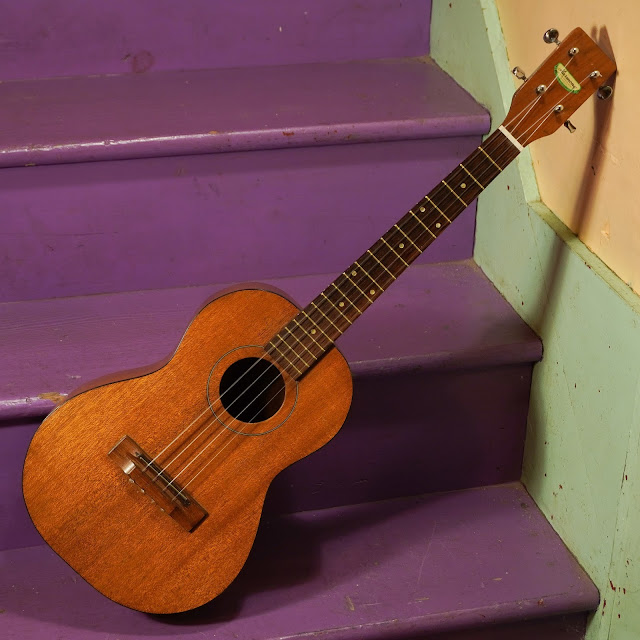1950s Harmony Baritone Ukulele
The old-style headstock decal plus the plastic (rather than bone) nut suggests that this guy dates to the late '50s. It's the usual fare for a Harmony baritone -- solid mahogany body, mahogany neck, and rosewood board and bridge. These '50s ones are built a little lighter than the '60s ones and tend to sound a little sweeter and more open.
This helps because I like to string these with "all plain" fluorocarbon strings (the tenor uke D'Addario EJ99TLG set) as heard in the video here. They're a little loose so a lighter touch is needed but they sound so much better than the 2-plain, 2-wound normal setup. It's much more "ukey" this way.
Anyhow, this uke came in a batch of consignment instruments and while it was in good shape overall, it did need a bit of sprucing-up to make it handle its best. That's been done and now it's a little sweetie with a perfect tone for relaxed front-porch or down-by-the-water strumming or fingerpicking.
Repairs included: fret level dress, side dots install, repair of damaged saddle slot (someone epoxied-in an aluminum saddle!) and conversion to fret-saddle install, cleaning, guitar-style tuners for the headstock, and setup.
Top wood: solid mahogany
Back & sides wood: solid mahogany
Bracing type: ladder
Bridge: rosewood
Fretboard: rosewood
Neck wood: mahogany
Action height at 12th fret: 1/16" overall (spot-on)
String gauges: D'Addario EJ99TLG all plain fluorocarbon
Neck shape: medium C
Board radius: flat
Neck relief: straight
Fret style: medium-small, brass
Scale length: 19 1/8"
Nut width: 1 5/16"
Body width: 10"
Body depth: 3 1/2"
Weight: 1 lb 13 oz
Condition notes: it's crack-free and looks good. The finish is satin and does show mild usewear throughout and some discoloration (moisture in the case?) damage on the back plus a little "rubbed" spot from arm-wear where the finish is worn almost entirely through. The bridge has some discoloration around the new fret saddle due to the need to build-up and then sand-down the saddle area. It had some splits in it from an earlier attempt at replacing the saddle with glued-in aluminum. It's good to go, though. I also added non-original side dots and replaced the (terrible) friction pegs with parts-bin '60s Japanese guitar tuners. They work just fine and are a lot easier to use than the friction pegs. They don't look out of place on the squared headstock, either.














Comments
Thanks
Willie